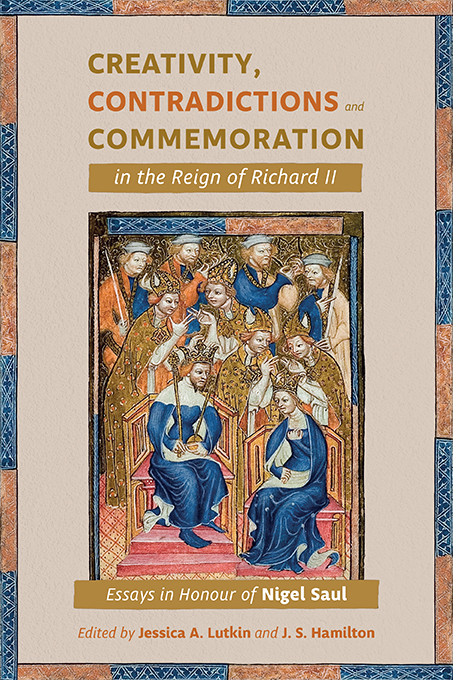 Creativity, Contradictions and Commemoration in the Reign of Richard II
Creativity, Contradictions and Commemoration in the Reign of Richard II Published online by Cambridge University Press: 26 May 2022
Nigel Saul was the first to note Richard II's obsession with burying favoured courtiers close to his tomb at Westminster Abbey. What is less well known is that the king was in fact copying a practice established some fifty years before by his great-grandmother, Isabella of France, in the great Franciscan church by Newgate in the city of London. It was here where the magnificent – but now lost – alabaster effigy of the Queen Mother was placed above her grave in the choir and close to the memorial slabs for members of her own household. She was buried with the heart of her murdered consort and – so it is alleged – near to the original resting place of her lover Mortimer. It is the purpose of this essay to examine the commemorative programme of Queen Isabella and to consider this as a precedent for the subsequent popularity of courtly burials and monuments at Grey Friars church. Their tombs are long gone, but the fortunate survival of a register of tombs, compiled in the 1520s, reveals a landscape of the dead that commemorated the great, the good, and the ordinary, and which served as a mausoleum for loyal Ricardians. It will be argued that it was this royal precedent that influenced King Richard's commemorative masterplan when he set out to surround his own tomb at Westminster with the remains of favoured liegemen, so that he would be flanked by them in death, as he had been in life.
Queen Isabella, widow of Edward II and daughter of Philip IV of France, died at Hertford castle on 22 August 1358. She was buried in the choir of the Franciscan church in London (Fig. 13.2) close to the tomb of her aunt and predecessor as queen consort, Margaret of France, who had died in 1318. Both queens were enthusiastic benefactors of the Friars Minor: around 1300, Queen Margaret paid for the construction of a chapel dedicated to her grandfather St Louis at the east end of the nave. This generosity was surpassed by her gift of some 2,000 marks towards the rebuilding of the great nave in the years that followed. She was considered as the ‘first foundress of our new church’ and was interred immediately before the high altar at the east end of the choir.
To save this book to your Kindle, first ensure [email protected] is added to your Approved Personal Document E-mail List under your Personal Document Settings on the Manage Your Content and Devices page of your Amazon account. Then enter the ‘name’ part of your Kindle email address below. Find out more about saving to your Kindle.
Note you can select to save to either the @free.kindle.com or @kindle.com variations. ‘@free.kindle.com’ emails are free but can only be saved to your device when it is connected to wi-fi. ‘@kindle.com’ emails can be delivered even when you are not connected to wi-fi, but note that service fees apply.
Find out more about the Kindle Personal Document Service.
To save content items to your account, please confirm that you agree to abide by our usage policies. If this is the first time you use this feature, you will be asked to authorise Cambridge Core to connect with your account. Find out more about saving content to Dropbox.
To save content items to your account, please confirm that you agree to abide by our usage policies. If this is the first time you use this feature, you will be asked to authorise Cambridge Core to connect with your account. Find out more about saving content to Google Drive.